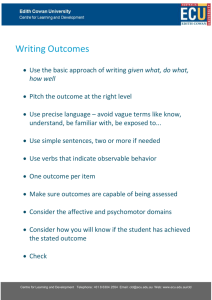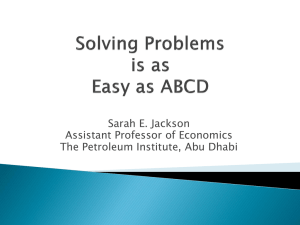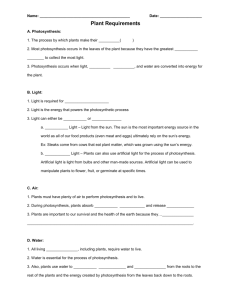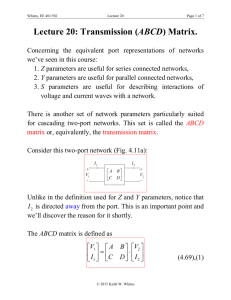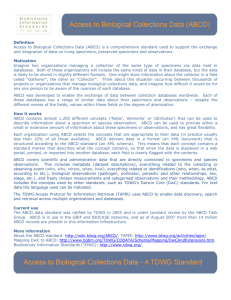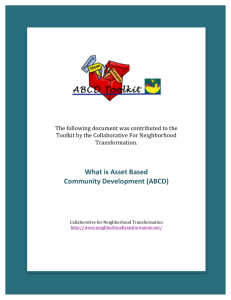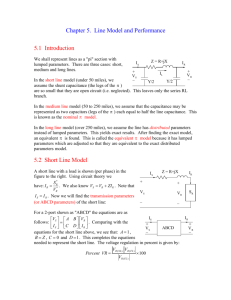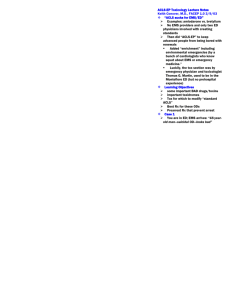Reflection Writing Learning Outcomes
advertisement
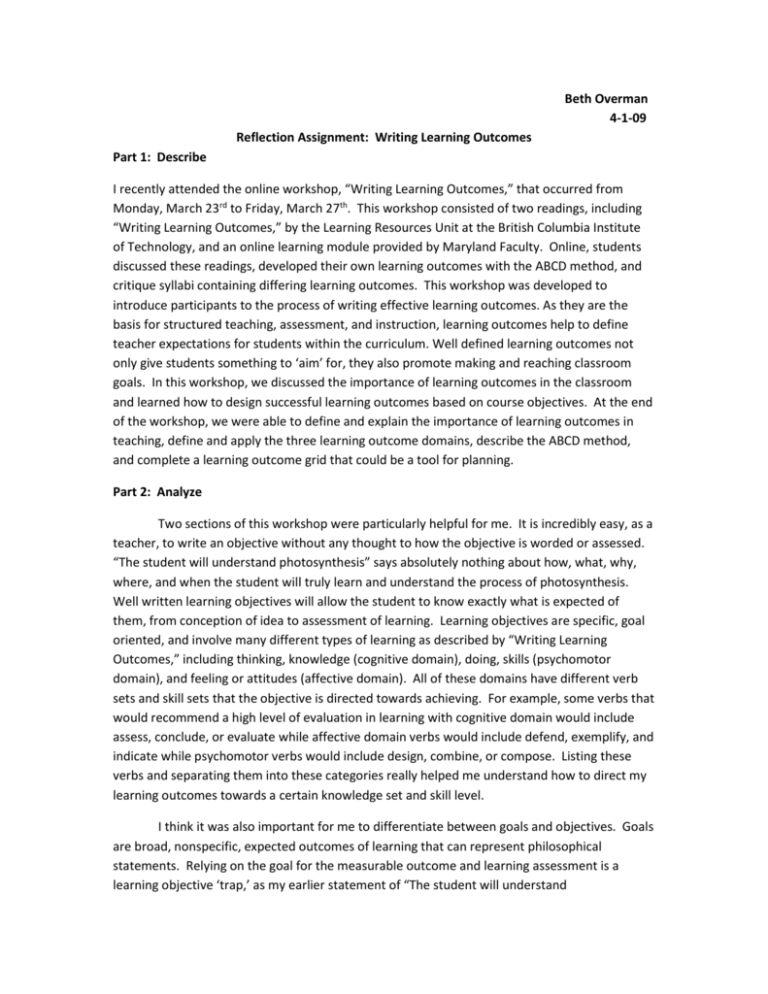
Beth Overman 4-1-09 Reflection Assignment: Writing Learning Outcomes Part 1: Describe I recently attended the online workshop, “Writing Learning Outcomes,” that occurred from Monday, March 23rd to Friday, March 27th. This workshop consisted of two readings, including “Writing Learning Outcomes,” by the Learning Resources Unit at the British Columbia Institute of Technology, and an online learning module provided by Maryland Faculty. Online, students discussed these readings, developed their own learning outcomes with the ABCD method, and critique syllabi containing differing learning outcomes. This workshop was developed to introduce participants to the process of writing effective learning outcomes. As they are the basis for structured teaching, assessment, and instruction, learning outcomes help to define teacher expectations for students within the curriculum. Well defined learning outcomes not only give students something to ‘aim’ for, they also promote making and reaching classroom goals. In this workshop, we discussed the importance of learning outcomes in the classroom and learned how to design successful learning outcomes based on course objectives. At the end of the workshop, we were able to define and explain the importance of learning outcomes in teaching, define and apply the three learning outcome domains, describe the ABCD method, and complete a learning outcome grid that could be a tool for planning. Part 2: Analyze Two sections of this workshop were particularly helpful for me. It is incredibly easy, as a teacher, to write an objective without any thought to how the objective is worded or assessed. “The student will understand photosynthesis” says absolutely nothing about how, what, why, where, and when the student will truly learn and understand the process of photosynthesis. Well written learning objectives will allow the student to know exactly what is expected of them, from conception of idea to assessment of learning. Learning objectives are specific, goal oriented, and involve many different types of learning as described by “Writing Learning Outcomes,” including thinking, knowledge (cognitive domain), doing, skills (psychomotor domain), and feeling or attitudes (affective domain). All of these domains have different verb sets and skill sets that the objective is directed towards achieving. For example, some verbs that would recommend a high level of evaluation in learning with cognitive domain would include assess, conclude, or evaluate while affective domain verbs would include defend, exemplify, and indicate while psychomotor verbs would include design, combine, or compose. Listing these verbs and separating them into these categories really helped me understand how to direct my learning outcomes towards a certain knowledge set and skill level. I think it was also important for me to differentiate between goals and objectives. Goals are broad, nonspecific, expected outcomes of learning that can represent philosophical statements. Relying on the goal for the measurable outcome and learning assessment is a learning objective ‘trap,’ as my earlier statement of “The student will understand photosynthesis” is more of a goal than an objective. Objectives are similar to goals and use specific information that allows them to be measured to determine if learning has taken place. I think the overall goal of “The student will understand photosynthesis,” when supported by objectives specifying “Given a plant leaf diagram, the student will be able to draw the pathway of photosynthesis through the strata of the leaf” is a strong assessment of learning. The ABCD method of learning objective construction is, I believe, a foolproof method of writing objectives. I think this is a great way to make sure that I am doing a good job of describing exactly what I need to teach and exactly what my students should be able to do after my lesson. This method breaks up the objective into several key parts that every objective should have, including Audience (who is the learner?), Behavior (what will the student be able to do?), Condition (what will they need?), and Degree (how well will they be able to do it?). With this system, the teacher can really just fill in the blanks to make a specific, well defined learning objective for the lesson. These learning objectives, if written well using the ABCD method, are clear, describe specific assignments, are observable and measurable, are quantitative and qualitative, are written in terms of performance, results oriented, and successful at communicating learning to the students. I really enjoyed being paired with other CoAT students and reviewing each other’s learning objectives. My partner, Robert Watson, wrote some really successful learning objectives. His first objective, “Given a scenario, desired information, and a model, the student will be able to apply mathematical relations and critical thinking skills to find the desired information, for all models being of the function types taught in the first half of the course (listed in the syllabus),” is very broad, but it is a great objective because it can be used for so many learning situations. Whether this objective is meant to discuss calculus, advanced functions, or algebra II, this objective should and can be met by students. This is the kind of objective that a student, if they can complete it successfully, will be successful on the final or midterm. His other objectives, including “Given a single or multi-variable function, the student will be able to perform all calculations involving the differentiation of the given function, for all function types listed,” or “Given the description and solution of a problem, the student will be able to communicate clearly the mathematical ideas which are related to the solution, to others who may not have had Calculus” are much more specific. I love the idea of students being able to communicate clearly math to other students who are not comfortable with the subject as an assessment of learning. These students will truly understand the material, as the highest form of assessment is being able to teach the information. I cannot wait to try this out on my students in a similar way, as it is a fun way to make sure they understand the objective. Learning how to write learning objectives is incredibly important for students and teachers at this level in education. In the public school system and the high school setting, huge emphasis is placed on goal/objective writing, as each and every lesson objective must correspond with a particular goal from that grade level’s Standard Course of Study. So, when students come to college, they are very used to having clear, clean, measurable objectives for every class that they are expected to successfully complete. When they come to college and receive little to no guidance or constructed organization in the class syllabus and course objectives, it’s no surprise they struggle to succeed. I am planning to start each class with an opening discussion question that is built upon the previous class learning objective. For example, I can place a PowerPoint slide on the projector screen with an EKG and ask them to describe the different events causing the waves, and those students will have successfully reviewed “Given an electrocardiogram, the student will be able to describe the different events occurring at each wave, as well as potential heart problems for all patients.” At the end of each unit, then, they can take each of these opening questions and have a great study guide and review for the exam, as well as successfully completed each of the learning objectives for the class. I think this kind of structure really helps students and teachers succeed in presenting and receiving information for a higher degree of learning, and ensures that students have the materials necessary to succeed in the course. Being able to write and assess objectives in this manner is critical to being a successful teacher, and I look forward to writing objectives and learning outcomes with the use of all the information I learned in this workshop.


